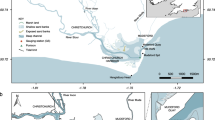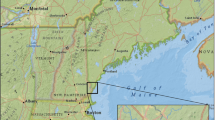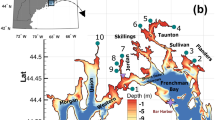Abstract
Numerical models are useful for predicting the transport and fate of contaminants in dynamic marine environments, and are increasingly a practical solution to environmental impact assessments. In this study, a three-dimensional hydrodynamic model and field data were used to validate a far-field dispersion model that, in turn, was used to determine the fate of treated wastewater (TWW) discharged to the ocean via a submarine ocean outfall under hypothetical TWW flows. The models were validated with respect to bottom and surface water current speed and direction, and in situ measurements of total nitrogen and faecal coliforms. Variations in surface and bottom currents were accurately predicted by the model as were nutrient and coliform concentrations. Results indicated that the ocean circulation was predominately wind driven, evidenced by relatively small oscillations in the current speeds along the time-scale of the tide, and that dilution mixing zones were orientated in a predominantly north-eastern direction from the outfall and parallel to the coastline. Outputs of the model were used to determine the ‘footprint’ of the TWW plume under a differing discharge scenario and, particularly, whether the resultant changes in TWW contaminants, total nitrogen and faecal coliforms would meet local environmental quality objectives (EQO) for ecosystem integrity, shellfish harvesting and primary recreation. Modelling provided a practical solution for predicting the dilution of contaminants under a hypothetical discharge scenario and a means for determining the aerial extent of exclusion zones, where the EQOs for shellfish harvesting and primary recreation may not always be met. Results of this study add to the understanding of regional discharge conditions and provide a practical case study for managing impacts to marine environments under a differing TWW discharge scenario, in comparison to an existing scenario.








Similar content being viewed by others
References
Australian and New Zealand Environment and Conservation Council (ANZECC)/Agriculture and Resource Management Council of Australia and New Zealand (ARMCANZ). (2000). Australian and New Zealand guidelines for fresh and marine water quality volume 1—the guidelines (pp. 3.3–14). Canberra: Australian and New Zealand Environment and Conservation Council, Agriculture and Resource Management of Australia.
Benfer, N. P., King, B. A., Lemckert, C. J., & Zigic, S. (2010). Modeling the effect of flow structure selection on residence time in an artificial canal system: case study. Journal of Waterway, Port, Coastal, and Ocean Engineering, 136, 91–96.
Boehm, A. B., Sanders, B. F., & Winant, C. D. (2002). Cross-shelf transport at Huntington Beach. Implications for the fate of sewage discharged through an offshore ocean outfall. Environmental Science and Technology, 36, 1899–1906.
Caraco, N., & Cole, J. J. (1999). Regional export of C, N, P and sediment: what river data tell us about key controlling variables. In J. D. Tenhunen & P. Kabat (Eds.), Integrating hydrology, ecosystem dynamics and biogeochemistry in complex landscapes (pp. 239–253). New York: Wiley.
Cederwall, H., & Elmgren, R. (1980). Biomass increase of benthic macrofauna demonstrates eutrophication of the Baltic Sea. Ophelia, 1, S287–S304.
Chambers, S.L., & James, R.N. (2005). Sonar termination as a cause of mass cetacean strandings in Geographe Bay, south-western Australia. Proceedings of ACOUSTICS 2005 - 9-11 November 2005 Busselton, Western Australia.
Chu, P. C., & Kyriakidis, K. (2011). Chemical spill characteristics in the San Diego Bay. Marine Technology Society Journal, 45, 52–58.
Cosgrove, J., Walker, D., Morrison, P., & Hillman, K. (2004). Periphyton indicate effects of wastewater discharge in the near-coastal zone, Perth (Western Australia). Estuarine, Coastal and Shelf Science, 61, 331–338.
Costanzo, S. D., O’Donohue, M. J., Dennison, W. C., Loneragan, N. R., & Thomas, M. (2001). A new approach for detecting and mapping sewage impacts. Marine Pollution Bulletin, 42, 149–156.
Creswell, G. R. (1991). The Leeuwin Current—observations and recent models. Journal of the Royal Society of Western Australia, 74, 1–14.
Davis, L. R. (1999). Fundamentals of environmental discharge modeling. Boca Raton: CRC Press.
Department of Health (Western Australia) and the University of Western Australia (2007). Microbial quality of recreational water guidance notes. In Support of Chapter 5 of the NHMRC Guidelines for Managing Risks in Recreational Waters 2007.
Downing, J. A., McClain, M., Twilley, R., Melack, J. M., Elser, J., Rabalais, N. N., Lewis, W. M., Turner, R. E., Jr., Corredor, J., Soto, D., Yanez-Arancibia, A., Kopaska, J. A., & Howarth, R. W. (1999). The impact of accelerating land use change on the N-cycle of tropical aquatic ecosystems: current conditions and projected changes. Biogeochemistry, 46, 109–148.
Egbert, G. D., Bennett, A. F., & Foreman, M. G. G. (1994). TPOEX/POSEIDON tides estimated using a global inverse model. Journal of Geophysical Research, 99, 24821–24852.
Fahrner, C.K., & Pattiaratchi, C.B. (1995). The physical oceanography of Geographe Bay, Western Australia. In Geographe Bay Summary Report, Wastewater 2040 Strategy for the South-West Region. Water Authority of Western Australia, Perth, 3–12.
Fang, T.-H., Nan, F.-H., Chin, T.-S., & Feng, H.-M. (2012). The occurrence and distribution of pharmaceutical compounds in the effluents of a major sewage treatment plant in Northern Taiwan and the receiving coastal waters. Marine Pollution Bulletin, 64, 1435–1444.
Feng, M., Wijffels, S., Godfrey, J. S., & Meyers, G. (2005). Do eddies play a role in the momentum balance of the Leeuwin Current? Journal of Physical Oceanography, 35, 964–975.
Figueiredo da Silva, J., Duck, R. W., Hopkins, T. S., & Anderson, J. M. (2002). Nearshore circulation revealed by wastewater discharge from a submarine outfall, Aveiro Coast, Portugal. Hydrology and Earth System Sciences, 6, 983–989.
Frick, W.E., Roberts, P.J.W., Davis, L.R., Keyes, J., Baumgartner, D.J., & George, K.P. (2000). Dilution models for effluent discharges, (4th Edition; Visual Plumes). U.S. Environmental Protection Agency–Environmental Research Division, NERL, Standards and Applied Science Division, Office of Science and Technology, Athens, Georgia.
Fu, L. L., Christensen, E. J., Yamarone, C. A., Jr., Lefebvre, M., Ménard, Y., Dorrer, M., & Escudier, P. (1994). TOPEX/POSEIDON mission overview. Journal of Geophysical Research: Oceans, 99, 24369–24381. 1978–2012.
Gorman, D., Russell, B. D., & Connell, S. D. (2009). Land-to-sea connectivity: linking human-derived terrestrial subsidies to subtidal habitat change on open rocky coasts. Ecological Applications, 19, 1114–1126.
Hanson, C. E., Pattiaratchi, C. B., & Waite, A. M. (2005). Seasonal production regimes off south-western Australia: influence of the Capes and Leeuwin currents on phytoplankton dynamics. Marine and Freshwater Research, 56, 1011–1026.
Kirkman, H., & Kuo, J. (1990). Pattern and process in southern Western Australian seagrasses. Aquatic Botany, 37, 367–382.
Kowalik, Z., & Murty, T. S. (1993). Numerical modelling of ocean dynamics. London: World Scientific Publishing. 481 pp.
Lemmens, S. (2003). Periphyton collectors as a tool to measure environmental performance of ocean outlets. Water Science and Technology, 47, 125–131.
Lourey, M. J., Dunn, J. R., & Waring, J. (2006). A mixed-layer nutrient climatology of Leeuwin Current and Western Australian shelf waters: seasonal nutrient dynamics and biomass. Journal of Marine Systems, 59, 25–51.
Machado, D. A., & Imberger, J. (2012). Managing wastewater effluent to enhance aquatic receiving ecosystem productivity: a coastal lagoon in Western Australia. Journal of Environmental Management, 99, 52–60.
Machado, D. A., & Imberger, J. (2014). Modeling the impact of natural and anthropogenic nutrient sources on phytoplankton dynamics in a shallow coastal domain, Western Australia. Environmental Fluid Mechanics, 14, 87–111.
Madala, R. V. (1977). A semi-implicit numerical model for baroclinic oceans. Journal of Computational Physics, 23, 167–178.
Matthai, C., & Birch, G. F. (2000). Trace metals and organochlorines in sediments near a major ocean outfall on a high energy continental margin (Sydney, Australia). Environmental Pollution, 110, 411–423.
Mayer, D. G., & Butler, D. G. (1993). Statistical validation. Ecological Modelling, 68, 21–32.
McCutcheon, S. C., Dongwei, Z., & Bird, S. (1990). Model calibration, validation, and use. In J. J. Martin, R. B. Ambrose, & S. C. McCutcheon (Eds.), Book III: estuaries, part 2: application of estuarine waste load allocation models. Washington: US Environmental Protection Agency, Office of Water.
McMahon, K., & Walker, D. I. (1998). Fate of seasonal, terrestrial nutrient inputs to a shallow seagrass dominated embayment. Estuarine, Coastal and Shelf Science, 46, 15–25.
McMahon, K., Young, E., Montgomery, S., Cosgrove, J., Wilshaw, J., & Walker, D. I. (1997). Status of a shallow seagrass system, Geographe Bay, south-western Australia. Journal of the Royal Society of Western Australia, 80, 255–262.
Muin, M., & Spaulding, M. (1996). Two-dimensional boundary-fitted circulation model in spherical coordinates. Journal of Hydraulic Engineering, 122, 512–521.
Muin, M., & Spaulding, M. L. (1997a). Application of three-dimensional boundary-fitted circulation model to Providence River. Journal of Hydraulic Engineering, 123, 13–20.
Muin, M., & Spaulding, M. L. (1997b). Three-dimensional boundary-fitted circulation model. Journal of Hydraulic Engineering, 123, 2–12.
Murray, A. G., Parslow, J., & Walker, S. (2001). Modelling treated waste disposal in Port Phillip Bay and Bass Strait: biogeochemical and physical removal. Environment International, 27, 249–255.
National Health and Medical Research Council (NHMRC). (2008). Guidelines for managing risks in recreational water. Canberra: National Health and Medical Research Council.
Nixon, S. W. (1982). Nutrient dynamics, primary production and fisheries yields of lagoons. Oceanologica Acta, 4, S357–S371.
Nixon, S. W. (1995). Coastal marine eutrophication: a definition, social causes, and future concerns. Ophelia, 41, 199–219.
Oceanica Pty Ltd. (2006a). Perth Long-Term Ocean Outlet Monitoring Programme—PLOOM 4.1 (2005–2006) Sepia Depression Data Report, Oceanica Consulting Pty Ltd, Report No. 478/1 prepared for the Water Corporation of Western Australia, Perth, Western Australia.
Oceanica Pty Ltd. (2006b). Perth Long-Term Ocean Outlet Monitoring Programme—PLOOM 4.1 (2005–2006) Swanbourne Data Report, Oceanica Consulting Pty Ltd, Report No. 478/2 prepared for the Water Corporation of Western Australia, Perth, Western Australia.
Oceanica Pty Ltd. (2006c). Perth Long-Term Ocean Outlet Monitoring Programme—PLOOM 4.1 (2005–2006) Ocean Reef Data Report, Oceanica Consulting Pty Ltd, Report No. 478/3 prepared for the Water Corporation of Western Australia, Perth, Western Australia.
Oceanica Pty Ltd. (2011). Ocean Outlet for Treated Wastewater: Bunbury Wastewater Treatment Plant; Section 45C Application for a Change to the Key Characteristics of Ministerial Statement 572. Oceanica Consulting Pty Ltd, Report No. 623_002/1 prepared for the Water Corporation of Western Australia, Perth, Western Australia.
Officer, C. B., & Ryther, J. H. (1977). Secondary sewage treatment versus ocean outfalls: an assessment. Science, 197, 1056–1060.
Okubo, A. (1971). Oceanic diffusion diagrams. Deep Sea Research, 8, 789–802.
Papakostidis, G., Grimanis, A. P., Zafiropoulos, D., Griggs, G. B., & Hopkins, T. S. (1975). Heavy metals in sediments from the Athens sewage outfall area. Marine Pollution Bulletin, 6, 136–139.
Parker, C. A., & O’Reilly, J. E. (1991). Oxygen depletion in Long Island Sound: a historical perspective. Estuaries, 14, 248–264.
Pastorok, R. A., & Bilyard, G. R. (1985). Effects of sewage pollution on coral-reef communities. Marine Ecology Progress Series, 21, 175–189.
Pearce, A. F. (1991). Eastern boundary currents of the southern hemisphere. Proceedings of the Royal Society of Western Australia, 74, 35–46.
Pearce, A., & Pattiaratchi, C. (1999). The Capes Current: a summer counter current flowing past Cape Leeuwin and Cape Naturaliste, Western Australia. Continental Shelf Research, 19, 401–420.
Pereira-Filho, J., Schettini, C. A. F., Rörig, L., & Siegle, E. (2001). Intratidal variation and net transport of dissolved inorganic nutrients, POC and chlorophyll a in the Camboriú River estuary, Brazil. Estuarine, Coastal and Shelf Science, 53, 249–257.
Roberts, P. J. W. (1991). Ocean outfalls. Critical Reviews in Environmental Control, 20, 311–339.
Sankaranarayanan, S. (2005). A 3D boundary-fitted barotropic hydrodynamic model for the New York Harbor region. Continental Shelf Research, 25, 2233–2260.
Sankaranarayanan, S., & French McCay, D. (2003a). Application of a two-dimensional depth-averaged hydrodynamic tidal model. Ocean Engineering, 30, 1807–1832.
Sankaranarayanan, S., & French McCay, D. (2003b). Three-dimensional modeling of tidal circulation in Bay of Fundy. Journal of Waterway, Port, Coastal and Ocean Engineering, 129, 114–123.
Scott, J. K. (1981). The seagrass fish fauna of Geographe Bay, Western Australia. Journal of the Royal Society of Western Australia, 63, 97–102.
Shang, D. Y., Macdonald, R. W., & Ikonomou, M. G. (1999). Persistence of nonylphenol ethoxylate surfactants and their primary degradation products in sediments from near a municipal outfall in the Strait of Georgia, British Columbia, Canada. Environmental Science & Technology, 33, 1366–1372.
Thompson, P., & Waite, A. (2003). Phytoplankton responses to wastewater discharges at two sites in Western Australia. Marine and Freshwater Research, 54, 721–735.
Twomey, L. J., Waite, A. M., Pez, V., & Pattiaratchi, C. B. (2007). Variability in nitrogen uptake and fixation in the oligotrophic waters off the south west coast of Australia. Deep-Sea Research II: Topical Studies in Oceanography, 54, 925–942.
United States of America Environmental Protection Agency (US EPA) (2006). Technical evaluation: physical characteristics of discharge US EPA document, 40 CFR 125.62 (a).
Vijay, R., Sardar, V. K., Dhage, S. S., Kelkar, P. S., & Gupta, A. (2010). Hydrodynamic assessment of sewage impact on water quality of Malad Creek, Mumbai, India. Environmental Monitoring and Assessment, 165, 559–571.
Waite, A. M., Thompson, P. A., Pesant, S., Feng, M., Beckley, L. E., Domingues, C. M., Gaughan, D., Hanson, C. E., Holl, C. M., Koslow, T., Meuleners, M., Montoya, J. P., Moore, T., Muhling, B. A., Paterson, H., Rennie, S., Strzelecki, J., & Twomey, L. (2007). The Leeuwin Current and its eddies: an introductory overview. Deep-Sea Research II: Topical Studies in Oceanography, 54, 789–796.
Washburn, L., Jones, B. H., Bratkovich, A., Dickey, T. D., & Chen, M.-S. (1992). Mixing, dispersion, and resuspension in vicinity of ocean wastewater plume. Journal of Hydraulic Engineering, 118, 35–58.
Water Corporation of Western Australia (Water Corporation) (2003). Integrated nearshore marine monitoring program for Southern Geographe Bay. Water Corporation of Western Australia, WA CCS 2051
Water Corporation of Western Australia (Water Corporation) (2010). Bunbury Ocean Outlet Monitoring (BOOM), http://www.watercorporation.com.au/B/boom.cfm. Accessed 3 Aug 2010.
Westera, M.B., Barnes, P.B, Kendrick G.A., & Cambridge M.L. (2007). Establishing benchmarks of seagrass communities and water quality in Geographe Bay, Western Australia. Project CM.01b. September 2007. University of Western Australia, School of Plant Biology. Report to the South West Catchments Council.
Western Australia Environmental Protection Agency (WA EPA) (2005). Environmental Quality Criteria Reference Document for Cockburn Sound (2003–2004)—a supporting document to the State Environmental (Cockburn Sound) Policy 2005, Prepared by Environmental Protection Authority, Report no. 20, Perth, Western Australia.
Willmott, C. J. (1981). On the validation of models. Physical Geography, 2, 184–194.
Wilson, B., Chen, R. F., Cantwell, M., Gontz, A., Zhu, J., & Olsen, C. R. (2009). The partitioning of triclosan between aqueous and particulate bound phases in the Hudson River Estuary. Marine Pollution Bulletin, 59, 207–212.
World Health Organisation (WHO) (1999). Health-based monitoring of recreational waters: the feasibility of a new approach (The Anapolis Protocol). Outcome of an expert consultation, Annapolis, USA.
Yassuda, E. A., Davie, S. R., Mendelsohn, D. L., Isaji, T., & Peene, S. J. (2000). Development of a waste load allocation model for the Charleston Harbor estuary, phase II: water quality. Estuarine, Coastal and Shelf Science, 50, 99–107.
Zaker, N. H., Imberger, J., & Pattiaratchi, C. (2007). Dynamics of the coastal boundary layer off Perth, Western Australia. Journal of Coastal Research, 23, 1112–1130.
Zigic, S., King, B., & Lemckert, C. J. (2005). Modelling the two-dimensional flow between an estuary and lake connected by a bi-directional hydraulic structure. Estuarine, Coastal and Shelf Science, 63, 33–41.
Acknowledgments
The authors would like to thank RPS ASA for access to the modelling software and program code. Philip Kindleysides (PK) kindly dedicated his own time to prepare the map, which is much improved over the original. The authors are also thankful to the Water Corporation of Western Australia for providing current profiler and water quality data in addition to kindly allowing the publication of this article. This study benefited greatly from data collected as part of the Bunbury Ocean Outlet Monitoring (BOOM) and the Perth Long-term Ocean Outlet Monitoring (PLOOM) programs undertaken since 2002 and the mid-1990s, respectively.
Author information
Authors and Affiliations
Corresponding author
Rights and permissions
About this article
Cite this article
Dunn, R.J.K., Zigic, S. & Shiell, G.R. Modelling the dispersion of treated wastewater in a shallow coastal wind-driven environment, Geographe Bay, Western Australia: implications for environmental management. Environ Monit Assess 186, 6107–6125 (2014). https://doi.org/10.1007/s10661-014-3843-1
Received:
Accepted:
Published:
Issue Date:
DOI: https://doi.org/10.1007/s10661-014-3843-1




